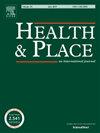城市形态与心血管健康:建筑环境影响的分层异质性解耦
IF 4.1
2区 医学
Q1 PUBLIC, ENVIRONMENTAL & OCCUPATIONAL HEALTH
引用次数: 0
摘要
建筑环境和交通可达性对社区心血管疾病(CVD)患病率的纵向影响尚未得到很好的探讨。此外,人们对社会和建筑环境特征与心血管疾病患病率之间的纵向联系的异质性程度知之甚少。本研究采用纵向生态研究设计,覆盖美国500个最大城市的26,631个社区(人口普查区)。通过整合两个时间点的交通、建筑和社会环境以及慢性疾病患病率的时变社区数据,利用了一种新的数据基础设施。在一个完整的贝叶斯框架中,基于马尔可夫链蒙特卡罗的分组相关随机参数模型被制定,以同时考虑未观察到的和相关的异质性影响。随着时间的推移,更适合步行的社区,其特征是更大的密度、街道连通性和土地使用组合,心血管疾病和高血压患病率更低。更大的交通可达性也与较低的患病率相关。相反,随着时间的推移,社会脆弱性较高的社区心血管疾病和高血压发病率较高。一项详细的事后社区水平评估显示,在社区和城市中,社会和建筑环境特征的影响存在显著的未观察到的相关异质性。深入了解这种异质性,以及社区心血管疾病和高血压患病率的决定因素,可以帮助公共卫生官员、工程师和政策制定者实施基于社区的局部行为干预措施,以实现更智能、更健康的城市。讨论了对国家疾病监测系统的影响。本文章由计算机程序翻译,如有差异,请以英文原文为准。
Urban form and cardiovascular health: Decoupling hierarchical heterogeneity in built environment impacts
Longitudinal impacts of the built environment and transit accessibility on neighborhood-level cardiovascular disease (CVD) prevalence are not well explored. Further, little is known about the magnitude of heterogeneity in the longitudinal links between social and built environment features and CVD prevalence. This study utilized a longitudinal ecological study design covering 26,631 neighborhoods (census tracts) in the 500 largest American cities. A novel data infrastructure is harnessed by integrating time-varying neighborhood-level data on transportation, the built and social environments, and chronic disease prevalence at two time points. In a full Bayesian framework, Markov Chain Monte Carlo-based grouped correlated random parameter models are formulated to simultaneously account for unobserved and correlated heterogeneity impacts. More walkable neighborhoods, characterized by greater density, street connectivity, and land-use mix, had lower CVD and hypertension prevalence over time. Greater transit accessibility was also correlated with lower disease prevalence. Conversely, neighborhoods with higher social vulnerability had greater CVD and hypertension rates over time. A detailed post hoc neighborhood-level assessment revealed significant unobserved and correlated heterogeneity in the impacts of social and built environment features across both neighborhoods and cities. Insights into this heterogeneity, as well as the determinants of neighborhood-level CVD and hypertension prevalence, can help public health officials, engineers, and policymakers implement localized community-based behavioral interventions for smarter and healthier cities. Implications for national disease surveillance systems are discussed.
求助全文
通过发布文献求助,成功后即可免费获取论文全文。
去求助
来源期刊

Health & Place
PUBLIC, ENVIRONMENTAL & OCCUPATIONAL HEALTH-
CiteScore
7.70
自引率
6.20%
发文量
176
审稿时长
29 days
期刊介绍:
he journal is an interdisciplinary journal dedicated to the study of all aspects of health and health care in which place or location matters.
 求助内容:
求助内容: 应助结果提醒方式:
应助结果提醒方式:


